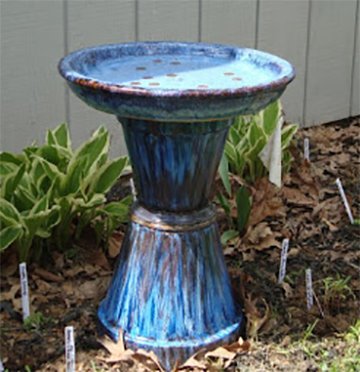birds and water
Although many birds receive some moisture from their food, most birds drink water every day, especially during hot weather, and also during extended dry periods when water is scarce.
They also need water for bathing, which loosens dirt and debris and makes their feathers easier to preen. The preening process is very important to maintaining their health and ability to fly – entailing the alignment of each feather, removal of parasites and the distribution of a protective layer of oil on their feathers, which they produce in a gland located at the base of their tail.
To help out your neighborhood birds, consider installing a simple birdbath to provide them with a reliable water source for drinking and bathing. If space allows, consider setting several birdbaths around your garden to ensure happy, healthy birds. You’ll enjoy watching the birds coming to the birdbath and might also attract new birds to your garden or patio.

A simple birdbath will provide birds with a reliable water source for drinking and bathing.
BIRDBATH BASICS
Keep it simple:
A good bird bath has a simple, sturdy construction, that is easy to clean and refill. Select a rough/textured material, like cement, terracotta or plastic so birds can grip it with their claws and not slip – avoid shiny, slippery containers. Metal works fine, too, but since metal will absorb heat, keep it out of the direct sun. Alfredo Garcia Lucio, co-owner of our local Camino Silvestre stores, advises against glass birdbaths as it also will heat the water, while sunlight penetrating through the glass can create hot spots that can burn grass, plants and even start a fire.
The simplest bird bath is a plant saucer with a textured finish and a stone in the middle. Or you could use cake pan or the lid from a small plastic trash can. If you would like something more decorative you could purchase a ready-made bird bath (check out Camino Silvestre or Amazon MX). Think about maintenance and ease of cleaning when making your decision.
Keep it shallow
A bird bath should be no more than 2 inches deep at its deepest point. Smaller birds can easily go in and splash around at this depth. You could always add a few large stones or pebbles in the water if your bird bath is deeper than desired. These will provide a safe space for the birds to stand on in and around the bath.
Keep it low and protected:
Most of the sources we checked say that birds seem to prefer bird baths at ground level, mimicking what they would find in nature, and placing it in a site that has shrubs or trees nearby that birds can use for preening or escape from a predator. If you have cats roaming your neighborhood, it’s best to elevate your bird bath on a post or pedestal.
Keep it cool:
Place your birdbath in the shade if possible, to keep the water cooler and fresher.
Keep it filled
During the hottest, driest times, many natural water sources may be dry, and birds can come to rely on a birdbath. If the water is not there, the birds can suffer. Keeping a full birdbath will also attract the widest number and variety of birds.
Keep it Clean
To provide a safe drinking and bathing environment, and to prevent mosquito eggs from hatching, it’s important to change the water every day or two. You can add copper coins to the bath to help prevent algae growth. Give it a good scrub every week or so, using a brush and white vinegar.
Keep it Moving
If you would like to go a step further with your birdbath, add a bubbler to circulate the water and draw the attention of the birds.

Pans and trash can lids (metal or plastic) witha large rock. What could be easier?

Terracotta saucers and pots are simple and inexpensive birdbath materials. Stack pots to elevate the saucer (or not), leave natural or decorate ( leave interior of saucer natural to minimize exposure to paint).
Subscribe to our newsletter
Our monthly newsletter will keep you up to date on our scheduled events, our work, and features monthly nature-related articles.
